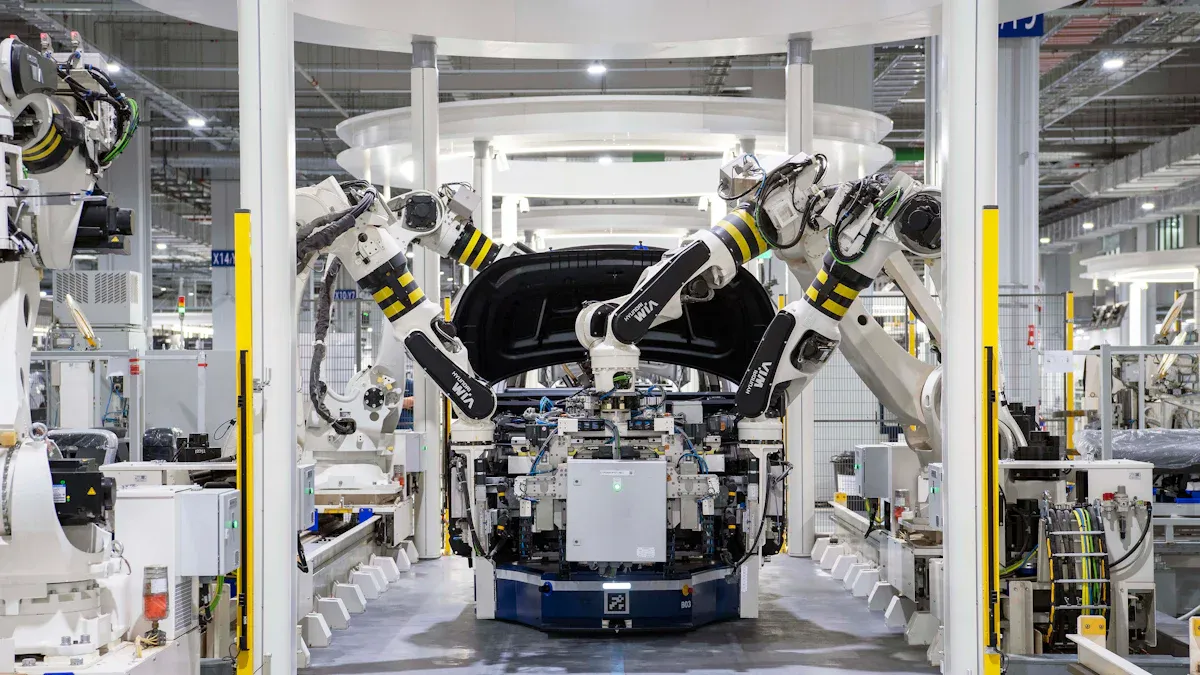
MPO-16 significantly reduces latency in German automotive smart factories. It provides high-density, high-bandwidth fiber optic connectivity. An MPO trunk cable system supports this infrastructure. This enables faster data transmission and processing, crucial for real-time operations and advanced automation. MPO-16 is foundational for enhancing efficiency, decision-making, and the performance of autonomous systems in automotive manufacturing. An MPO Harness Cable further optimizes connections within these advanced systems.
Key Takeaways
- MPO-16 fiber optic cabling greatly reduces delays in smart factories. It uses many fibers for fast data.
- Low latency is vital for German car factories. It makes production efficient and helps robots work better.
- MPO-16 cables support very fast internet speeds. This includes 400G Ethernet and even faster systems.
- MPO-16 helps collect data quickly from sensors. This allows computers to make faster decisions at the factory edge.
- MPO trunk cables prevent network slowdowns. They ensure data flows smoothly without waiting.
- MPO-16 provides precise communication for robots. This helps automated production lines work together perfectly.
- MPO-16 works well with private 5G networks. This creates a strong and flexible communication system for factories.
- MPO-16 is built to last in tough factory settings. It helps factories prepare for future technology needs.
Understanding Latency in Smart Factories
Defining Latency in Industrial Automation
Data Transmission Delays in Production Systems
Latency represents a critical factor in modern industrial environments. In industrial automation, particularly within motion control networks, latency defines the duration a message or packet takes to travel from its origin to its destination. This delay can originate from physical network components. Cables and switches contribute to this delay. Routing processes through electrical and electronic pathways also cause delays. While minimizing latency is ideal for precise control, a certain amount of consistent and known latency can often be managed effectively. However, unpredictable or excessive delays disrupt operations.
Impact on Sensor-to-Actuator Response Times
Latency directly impacts the response times between sensors and actuators. Sensors collect vital data from the factory floor. Actuators then perform actions based on this data. High latency means a significant delay between a sensor detecting an event and an actuator responding to it. This delay can lead to imprecise movements in robotics or delayed adjustments in machinery. Such issues compromise product quality and operational safety.
Why Low Latency is Critical for German Automotive Manufacturing
Enhancing Production Efficiency and Throughput
Low latency is paramount for German automotive manufacturing. It directly enhances production efficiency and throughput. Edge computing significantly improves predictive maintenance systems. This enables quicker predictions and immediate actions. These actions lead to smoother production processes, extended machinery lifespan, and minimized unexpected downtime. Real-time reactions allow instant monitoring and response to machine performance. This includes temperature fluctuations or fault detection, preventing downtime and costly errors.
Enabling Real-time Decision-Making and Control
Automotive smart factories rely on real-time data for critical decisions. Low latency networks ensure that data from every part of the production line arrives instantly. This allows plant managers and automated systems to make immediate, informed decisions. They can adjust production parameters, reallocate resources, or halt operations if necessary. This level of control prevents costly mistakes and optimizes workflow.
Supporting Autonomous Systems and Robotics
Autonomous systems and robotics form the backbone of modern automotive manufacturing. These systems require precise, instantaneous communication. Low latency ensures that autonomous guided vehicles (AGVs) navigate safely and efficiently. Robotic arms perform complex assembly tasks with exact timing. Any delay can cause collisions, errors, or production bottlenecks. Edge AI processes data locally, significantly improving speed and reducing latency in critical operations like autonomous robotics. This is crucial for seamless production.
Facilitating Predictive Maintenance and Quality Control
Low latency networks are essential for advanced predictive maintenance and quality control. Optimized predictive maintenance processes machine data locally. This enables early detection of wear and tear. It reduces unplanned outages and extends equipment life. Enhanced quality control benefits from real-time data analytics. This facilitates immediate identification of quality issues. It allows for corrective actions before defects escalate. Automotive plants utilize edge devices for instant analysis of sensor data from robotic assembly lines. This ensures precision and reduces faults.
MPO-16 Technology for High-Speed Connectivity
What is MPO-16 Fiber Optic Cabling?
Multi-Fiber Design and Higher Fiber Count
MPO-16 fiber optic cabling technology uses Multi-fiber Push On (MPO) connectors. These connectors specifically feature 16 fibers. They are essential for high-speed parallel fiber optic applications. For example, 800 Gig and future 1.6 Terabit systems rely on MPO-16. These systems facilitate data transmission with 8 fibers transmitting and 8 receiving. Each fiber operates at speeds like 100 Gbps or 200 Gbps per lane. MPO-16 connectors have a linear array of fibers within a single ferrule. They also feature an offset key for proper mating. Recent advancements include very small form factor (VSFF) 16-fiber MPOs. These significantly increase density, allowing more connections in less space within high-performance computing environments.
Advantages Over Traditional MPO-12 Connectors
MPO-16 connectors offer distinct advantages over traditional MPO-12 connectors. They provide a higher fiber count within a similar physical footprint. This enhances density and performance for next-generation networks. The following table highlights key differences:
| Feature | MPO-12 Connector | MPO-16 Connector |
|---|---|---|
| Fiber Arrangement | 1×12 (Single Row) | 1×16 (Single Row) |
| Dominant Applications | 100G (SR4), 40G BiDi | 200G/400G Breakout, 400G SR8 |
| Key Speed Support | 40G, 100G | 200G, 400G |
| Density Rating | ★★★☆☆ | ★★★★☆ |
| Breakout Efficiency | Medium (e.g., 12f -> 3x10G) | High (e.g., 16f -> 2x200G or 1x400G) |
| Primary Use Case Today | Mainstream 100G, Migration Paths | Next-Gen 200G/400G Deployments |
| Density Advantage | Balanced | Doubles fiber count within same physical connector space as 12f single-row MPO, boosting rack density |
MPO-16 connectors double the fiber count within the same physical connector space as a 12-fiber single-row MPO. This significantly boosts rack density.
How MPO-16 Enhances Data Throughput and Bandwidth
Increased Fiber Density for Parallel Optical Transmission
The MPO-16 cable consolidates 16 fibers into a compact form factor. This design addresses bandwidth challenges in demanding industries. These include 5G, AI, and hyperscale computing. MPO-16 enables 400Gbps links by utilizing 8 fibers for transmission (Tx) and 8 for reception (Rx). This eliminates the need for parallel ribbon cables. The high-density design is crucial for data centers and high-speed networks. It allows more fiber connections in limited spaces.
Supporting Higher Data Rates for Network Infrastructure
MPO-16 connectors support up to 16 fiber connections per connector. This significantly increases connection density compared to traditional 8 or 12 fiber connectors. MPO-16 is an ideal choice for high-speed network environments. These include 400GbE and 800GbE systems. It ensures stable and efficient data transmission. MPO-16 fiber optic cables support 400G and higher transmission rates. They offer excellent performance, high density, stability, and flexibility. The MPO-16 solution supports high-speed transmission requirements such as 400G and 800G. It effectively manages increasing data traffic and meets growing bandwidth demands for efficient and stable data transmission.
Direct Mechanisms: MPO-16 Reduces Latency
MPO-16 technology directly addresses the challenge of latency in smart factories. It provides the necessary infrastructure for rapid data exchange. This high-performance connectivity ensures that critical information moves swiftly across the network. Consequently, it enables real-time operations and enhances overall system responsiveness.
Enabling Higher-Speed Ethernet Protocols
MPO-16 plays a pivotal role in supporting the next generation of Ethernet protocols. These protocols are essential for the massive data volumes generated in smart factories.
Supporting 400G Ethernet and Beyond
MPO-16 connectors are fundamental for implementing ultra-high-speed Ethernet. They facilitate the deployment of 400G Ethernet and even faster standards. For instance, MMC-16 cables, a specific type of MPO-16, currently support 2×400 Gig, 800 Gig, and 1.6 Terabit (2×800 Gig) applications. With the introduction of 200 Gb/s lane rates, these cables will be capable of supporting future 3.2 Terabit (2×1.6 TB) applications. This capability ensures the network can handle increasing data demands. The industry also sees MPO-16 connectors in standards like 400GBASE-SR8, which uses a 50 Gb/s lane rate.
| Ethernet Standard | Lane Rate | Connector Type |
|---|---|---|
| 400GBASE-SR8 | 50 Gb/s | MPO-16/MPO-24 |
Accelerating Data Packet Transmission
Higher Ethernet speeds directly translate into faster data packet transmission. MPO-16’s ability to support these advanced protocols means data packets travel across the network with minimal delay. This acceleration is crucial for time-sensitive applications. It ensures that commands reach machines and sensors report data almost instantaneously.
Optimizing Data Aggregation at the Edge
Smart factories generate vast amounts of data at the edge, from countless sensors and machines. MPO-16 significantly optimizes the collection and processing of this data.
Faster Data Collection from Sensors and Machines
MPO-16’s high-density fiber count allows for the rapid aggregation of data from numerous edge devices. It connects a multitude of sensors, cameras, and robotic systems to the network backbone efficiently. This rapid collection minimizes the time data spends waiting to be transmitted from its source. It ensures that the central systems receive a comprehensive and up-to-date view of factory operations.
Quicker Localized Edge Computing Decisions
Efficient data aggregation directly supports quicker localized edge computing decisions. With MPO-16, edge servers receive data streams from connected devices at extremely high speeds. This enables immediate processing and analysis right where the data originates. Consequently, autonomous systems and localized control units can make decisions and execute actions without relying on a round trip to a central cloud, drastically reducing response times.
Reducing Network Congestion with MPO Trunk Cables
Network congestion is a primary cause of latency. MPO-16, particularly when deployed as an MPO trunk, effectively mitigates this issue.
Minimizing Data Queuing and Bottlenecks
High-bandwidth MPO trunk cables provide ample capacity for data traffic. They prevent data packets from queuing up and creating bottlenecks within the network. By offering multiple parallel data paths, an MPO trunk ensures that information flows freely. This design avoids the delays associated with overcrowded network segments.
Ensuring Smooth and Immediate Information Flow
The robust capacity of an MPO trunk guarantees a smooth and immediate flow of information. This uninterrupted data transfer is vital for maintaining the synchronization of complex manufacturing processes. It ensures that every component of the smart factory, from robotic arms to quality control systems, operates with the most current data. This seamless communication is essential for achieving the precision and efficiency demanded by German automotive production.
Supporting Real-time Control Systems and Robotics
MPO-16 technology provides the backbone for the sophisticated real-time control systems and robotics found in German automotive smart factories. These advanced systems demand immediate data exchange and precise synchronization. MPO-16’s high-bandwidth capabilities directly address these critical requirements.
Precise Communication for Automated Production Lines
Automated production lines in modern automotive factories operate with intricate coordination. Each machine, sensor, and actuator must communicate seamlessly and without delay. MPO-16 fiber optic cabling ensures this precise communication. It transmits vast amounts of data at extremely high speeds. This capability allows for the real-time synchronization of complex processes. For example, a robotic arm performing a welding task needs immediate feedback from vision systems. It also requires precise instructions from the central control unit. MPO-16 minimizes the latency in these data transfers. This ensures every component on the line acts in perfect unison. Such precision prevents errors, reduces waste, and maintains high production quality.
Tip: Low latency communication is vital for maintaining the delicate balance and synchronization required in highly automated assembly lines, preventing costly misalignments or production halts.
Instantaneous Response for AGVs and Robotic Arms
Autonomous Guided Vehicles (AGVs) and robotic arms are integral to automotive manufacturing. They require instantaneous responses to dynamic factory environments. MPO-16 provides the necessary low-latency connectivity for these critical assets. AGVs navigate complex routes, avoiding obstacles and delivering parts with exact timing. Their control systems rely on immediate data from environmental sensors and central traffic management. MPO-16 ensures these data packets arrive without delay, allowing AGVs to react instantly to changes. Similarly, robotic arms execute highly repetitive and precise movements. They often work in close proximity to other robots or human operators. Any lag in their control signals could lead to safety hazards or production flaws. MPO-16 enables the rapid transmission of commands and sensor feedback. This guarantees the robotic arms respond with the required speed and accuracy, enhancing both efficiency and safety on the factory floor.
MPO-16 in German Automotive Smart Factory Applications

MPO-16 technology finds extensive application within German automotive smart factories. It provides the high-speed, low-latency connectivity essential for advanced manufacturing processes. This robust infrastructure supports critical operations across various factory domains.
Automated Production Lines and Assembly
MPO-16 significantly enhances the performance of automated production lines and assembly processes. It ensures seamless communication and precise control for complex manufacturing tasks.
Real-time Synchronization for Complex Processes
Automotive production lines involve numerous interconnected stages. Each stage requires precise timing and coordination. MPO-16 enables real-time synchronization across these complex processes. It transmits large data packets between machines, robots, and control systems almost instantly. This immediate data exchange ensures all components operate in perfect harmony. For example, a welding robot receives instructions precisely when the chassis arrives at its station. This prevents delays and maintains a continuous workflow. The high bandwidth of MPO-16 prevents data bottlenecks, which could otherwise disrupt the synchronized flow.
Enhancing Robotic Precision and Coordination
Robotic systems perform intricate tasks in automotive assembly. They require extreme precision and coordination. MPO-16 provides the low-latency communication necessary for these robots. It ensures robotic arms receive commands and send feedback without delay. This allows for highly accurate movements and precise positioning. When multiple robots collaborate on a single task, MPO-16 facilitates their synchronized operation. They can avoid collisions and execute complex maneuvers together. This enhanced coordination improves assembly quality and speeds up production cycles.
Quality Control and Vision Systems
Quality control and vision systems are vital for maintaining high standards in automotive manufacturing. MPO-16 significantly boosts their effectiveness through rapid data handling.
Rapid Image and Data Transfer for AI-Driven Inspection
Modern quality control relies heavily on high-resolution vision systems and AI-driven inspection. These systems generate massive amounts of image and video data. MPO-16 facilitates the rapid transfer of this data to processing units. It handles gigabytes of visual information from multiple cameras simultaneously. This high-speed transfer is crucial for AI algorithms. They need immediate access to data for real-time analysis. Without MPO-16’s capacity, data transfer could become a bottleneck, slowing down the inspection process.
Accelerating Defect Detection and Analysis
Fast data transfer directly accelerates defect detection and analysis. AI systems can process images from the production line almost instantly. They identify anomalies or defects in components or assembled parts. MPO-16 ensures these AI systems receive the visual data quickly. This allows for immediate identification of issues. Plant operators can then take corrective actions without delay. This proactive approach minimizes waste and prevents defective products from moving further down the line. It significantly improves overall product quality.
Predictive Maintenance and IoT Sensor Networks
Predictive maintenance relies on continuous data collection from numerous sensors. MPO-16 provides the robust network infrastructure for these extensive IoT sensor networks.
Managing Massive Data Streams from IoT Devices
Smart factories deploy thousands of IoT sensors on machinery, tools, and environmental controls. These sensors continuously generate data streams about temperature, vibration, pressure, and performance. MPO-16 offers the necessary bandwidth to manage these massive data streams. It aggregates data from countless devices efficiently. This prevents network congestion, which could otherwise lead to data loss or delays. The high capacity ensures all sensor data reaches the central analytics platforms reliably.
Enabling Immediate Analysis for Proactive Maintenance
Immediate analysis of sensor data is critical for effective predictive maintenance. MPO-16’s low-latency capabilities enable real-time data processing. Analytics platforms can instantly detect deviations from normal operating parameters. They identify potential equipment failures before they occur. For example, a sudden increase in vibration data triggers an immediate alert. Maintenance teams can then address the issue proactively. This prevents unexpected downtime and costly repairs. MPO-16 ensures the data arrives quickly enough for these proactive interventions.
Integration with Private 5G Networks
MPO-16 technology does not operate in isolation. It forms a powerful synergy with private 5G networks within German automotive smart factories. This integration creates a comprehensive, low-latency communication infrastructure. It combines the reliability and immense bandwidth of fiber optics with the flexibility and mobility of wireless technology. This dual approach addresses the diverse connectivity needs of a modern factory.
Complementing Wireless Low-Latency Infrastructure
MPO-16 serves as the high-capacity backbone for private 5G networks. It provides the essential wired infrastructure that supports wireless communication. 5G base stations and access points require robust, low-latency connections to the core network. MPO-16 trunk cables deliver this critical connectivity. They ensure that data from wireless devices, like mobile robots or handheld scanners, reaches central processing units without delay. This setup allows 5G to focus on its strengths: providing flexible, low-latency wireless access for mobile assets. MPO-16 handles the high-volume, static data links. This includes connections to servers, data centers, and fixed machinery. The combined system leverages the best of both worlds. MPO-16 offers stable, ultra-high-throughput links. Private 5G provides mobility and real-time communication for dynamic factory elements. This ensures the entire network maintains its low-latency performance.
Enhancing Fluid Factory Environments
The integration of MPO-16 with private 5G networks creates truly fluid factory environments. This combination enables unprecedented flexibility and responsiveness in manufacturing operations. Production lines can undergo rapid reconfigurations. This happens without extensive rewiring, thanks to the wireless capabilities of 5G. MPO-16 ensures the wired segments of the network can handle the increased data flow from these dynamic changes. Mobile robots and Autonomous Guided Vehicles (AGVs) operate seamlessly. They communicate over the 5G network, while MPO-16 connects their charging stations and central control systems. This allows for dynamic routing and real-time task allocation. Human-robot collaboration also benefits significantly. Workers use wireless devices for augmented reality applications or remote control. MPO-16 ensures the underlying data infrastructure supports these bandwidth-intensive applications. The seamless data flow between fixed and mobile assets creates an adaptive and agile manufacturing environment. This empowers factories to respond quickly to market demands and production changes.
Strategic Implementation of MPO-16 Trunk Cables

German automotive smart factories must strategically implement MPO-16 trunk cables. This ensures they maximize the benefits of high-speed, low-latency connectivity. Careful planning, design, installation, and maintenance are crucial for optimal performance and long-term reliability.
Planning and Design for High-Density Infrastructure
Effective planning and design lay the groundwork for a robust MPO-16 infrastructure. This ensures the network meets current demands and adapts to future needs.
Optimizing Network Topologies for Low Latency
Scalability for Future Data Demands
MPO-16 infrastructure must support future data demands. The design incorporates higher fiber counts than immediately necessary. This accommodates future upgrades and minimizes re-cabling costs. Planning for scalability ensures the network remains agile and responsive to technological advancements.
Ensuring Proper Installation and Maintenance
Proper installation and diligent maintenance are critical for the sustained performance of MPO-16 cabling in industrial settings.
Best Practices for Fiber Optic Deployment
Long-term Reliability in Industrial Environments
MPO-16 trunk cables are engineered for durability and reliability in harsh industrial environments. They feature wide temperature tolerance, high tensile strength, and a minimum bending radius. This ensures consistent performance even in challenging installation conditions. MPO/MTP cables incorporate advanced moisture barrier technology, watertight cable jackets, and precise sealing mechanisms. These prevent degradation from humidity. Materials used are highly resistant to common environmental pollutants, cleaning solvents, and industrial chemicals. Manufacturing processes include extensive durability testing. This includes bend testing, mechanical testing (thousands of mating cycles), and environmental stress testing. Routine inspections, including connector checks with fiber scopes and OTDR tests, identify anomalies. Regular cleaning with specialized tools maintains connector end faces. Proper storage in clean, controlled environments prevents damage. Avoiding environmental hazards like heat, moisture, and electromagnetic interference further enhances reliability. Addressing polarity issues by verifying adapter types and connector orientation is also crucial.
The Future of Low-Latency Manufacturing with MPO-16
Facilitating Real-time Data Analytics and AI Integration
Powering Advanced Machine Learning Applications
MPO-16 provides the high-bandwidth backbone essential for advanced machine learning applications. These applications drive intelligence in smart factories. They process vast datasets from production lines. Low latency ensures that machine learning models receive real-time data. This allows for immediate insights and rapid model updates. Factories can deploy AI for predictive quality control or complex process optimization. MPO-16 ensures these AI systems operate at peak efficiency.
Enabling Adaptive Manufacturing Processes
Adaptive manufacturing processes rely on instant data feedback and rapid decision-making. MPO-16’s low-latency connectivity enables this agility. Production lines can dynamically adjust to changing demands or detected anomalies. For example, AI systems can reconfigure robotic tasks in real-time. They can optimize material flow based on live sensor data. This responsiveness allows factories to achieve greater flexibility and efficiency. It supports personalized production and rapid prototyping.
Enhancing Cybersecurity Through Faster Network Response
Quicker Threat Detection and Mitigation
Low-latency networks significantly enhance cybersecurity in smart factories. MPO-16 enables security systems to detect threats almost instantly. It facilitates rapid data transfer to intrusion detection systems and security analytics platforms. This speed allows for quicker identification of suspicious activities or unauthorized access attempts. Immediate detection means security teams can mitigate threats before they cause significant damage. This proactive approach protects critical operational technology (OT) systems.
Resilient Network Operations
MPO-16 contributes to more resilient network operations. Its high bandwidth and reliability reduce the risk of network bottlenecks. These bottlenecks can be exploited by attackers or cause system failures. Faster network response times also support rapid recovery from cyber incidents. Systems can isolate compromised segments and restore services quickly. This resilience ensures continuous operation, even when facing sophisticated cyber threats.
Future-Proofing Network Infrastructure
Meeting Evolving Demands of Industry 4.0
MPO-16 is crucial for meeting the evolving demands of Industry 4.0. It directly addresses the high-density and high-speed requirements of modern data-intensive applications. These applications include AI/ML, cloud computing, and big data analytics. All these necessitate unparalleled data transmission and processing speeds. The MPO-16 facilitates these demands by supporting technologies like 800G and 2x400G transceivers. The focus on smart city and Industry 4.0 initiatives drives the adoption of multi-fiber parallel optics. This leads to a significant acceleration in MPO connector sales. Government-backed digital infrastructure projects also boost fiber rollouts and increase demand for MPO solutions.
Supporting Next-Generation Automotive Production
MPO-16 actively supports next-generation automotive production. It provides the foundational infrastructure for advanced manufacturing.
As IBM’s VP of Cloud Infrastructure, Dr. Sarah Aerni, notes, “MPO 16 isn’t just about density—it’s the foundation for rearchitecting exascale systems with photonic determinism.”
MPO-16 cables are designed to meet the demands of AI, 5G-Advanced networks, and quantum computing. These are key components of Industry 4.0. They offer 33% higher port density than traditional 12-fiber MPOs. This reduces hyperscale deployment costs. Innovations include nano-fabricated ferrules, self-diagnostic capabilities, and sustainable materials. Features like Quantum-Secure Shielding integrate anti-tamper FBG sensors and 50 dB crosstalk suppression. Self-monitoring cables embed MEMS sensors to detect microbends and temperature spikes. This enables SDN rerouting before signal degradation. Meta’s RSC-2024 AI SuperCluster deploys 16,384 MPO 16 cables to interconnect 24,576 NVIDIA GB200 GPUs. This reduces cabling mass by 28 tons. Ericsson’s Streetmacro 6705 radios use waterproof MPO 16 cables for 25G eCPRI interfaces. This enables Verizon’s 2024 C-band rollout with less than 50 μs latency. MPO-16 fiber infrastructure provides flexibility for networking backbone design. It offers additional densification benefits within data halls and racks.
MPO-16 stands as a critical enabler for achieving ultra-low latency in German automotive smart factories. Its high-density, high-bandwidth capabilities directly drive efficiency, foster innovation, and enhance competitiveness. This technology is foundational for the next generation of automated, intelligent, and responsive manufacturing processes. MPO-16 empowers real-time decision-making, supports advanced robotics, and fuels predictive analytics, thereby shaping the future of automotive production.
FAQ
What is MPO-16 fiber optic cabling?
MPO-16 fiber optic cabling uses Multi-fiber Push On connectors. These connectors feature 16 fibers within a single ferrule. They support high-speed parallel optical transmission. MPO-16 is crucial for 400G Ethernet and beyond. It provides high-density connectivity for demanding network environments.
How does MPO-16 reduce latency in smart factories?
MPO-16 reduces latency by enabling higher-speed Ethernet protocols. It supports 400G and 800G data rates. This accelerates data packet transmission. It also optimizes data aggregation at the edge. This allows quicker localized computing decisions. MPO-16 minimizes network congestion.
Why is low latency critical for German automotive manufacturing?
Low latency is critical for enhancing production efficiency. It enables real-time decision-making and control. Low latency supports autonomous systems and robotics. It facilitates predictive maintenance and quality control. This ensures precise operations and prevents costly delays.
What advantages does MPO-16 offer over traditional MPO-12 connectors?
MPO-16 offers a higher fiber count within a similar physical footprint. It doubles the fiber density compared to MPO-12. This boosts rack density. MPO-16 supports next-generation 200G/400G deployments. It provides more efficient breakout capabilities for higher bandwidth needs.
Can MPO-16 integrate with private 5G networks in factories?
Yes, MPO-16 integrates seamlessly with private 5G networks. It serves as the high-capacity wired backbone. MPO-16 connects 5G base stations and core network components. This combination provides robust, low-latency communication. It supports both fixed and mobile assets in fluid factory environments.
Is MPO-16 suitable for harsh industrial environments?
Yes, MPO-16 cables are engineered for durability. They feature wide temperature tolerance. They have high tensile strength. MPO-16 includes advanced moisture barrier technology. It resists industrial chemicals. This ensures reliable performance in challenging factory conditions.
How does MPO-16 support AI and machine learning applications?
MPO-16 provides the high-bandwidth backbone for AI and machine learning. It enables rapid image and data transfer for AI-driven inspection. This accelerates defect detection. It manages massive data streams from IoT sensors. This facilitates immediate analysis for proactive maintenance.



